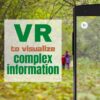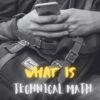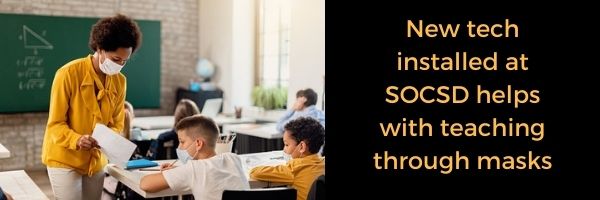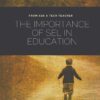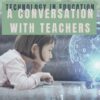Category: Education reform
Has Teaching Changed since the Pandemic?
Ask a Tech Teacher contributor, Christian Miraglia, wrote an interesting article on changes in teaching since the pandemic. I think you’ll find a lot to relate to:
Has Teaching Changed Since the Pandemic?
March 13, 2019, for many educators in California and nationwide, was a day that will forever be etched in their memories. It was the day that many school districts closed temporarily, or so they thought, due to the spread and uncertainty of COVID-19. What nobody could have seen was that these closures would become more permanent and reshape the educational landscape for years to come. Changes to daily instruction have become the norm as students were absent due to illness, teachers were absent due to COVID-19 exposure or their children having been infected or exposed, in-face instruction shifting to online and then back to face-to-face.
Recently I listened to K-12 educators at a session hosted by a local university designed to have teachers meet and share their experiences from the past two years. The output of emotions from these brave educators who detailed what it is like to teach during this challenging time was gut-wrenching.
The resiliency of these educators is to be commended as they navigated the daily challenges of policy changes, students coming and leaving, the caring for themselves and their children. In listening to them, a common theme resonated from the group, the value of networking.
Share this:
- Click to share on Facebook (Opens in new window) Facebook
- Click to share on X (Opens in new window) X
- Click to share on LinkedIn (Opens in new window) LinkedIn
- Click to share on Pinterest (Opens in new window) Pinterest
- Click to share on Telegram (Opens in new window) Telegram
- Click to email a link to a friend (Opens in new window) Email
- More
Is Education Due for a Reset
Throughout my career in education, teaching has been prodded, pushed, tweaked, nudged, and reformed. I author a K-12 Technology Curriculum. Each time I update it, I include a list of what has changed since the last update, something like:
- Windows updated its platform—twice.
- Student work is often collaborative and shared.
- Student work is done anywhere; it must be synced and available across multiple platforms, devices.
- Keyboarding skills are critical, especially to summative year-end testing.
- Technology is the norm, but teacher training isn’t.
- Education is focused on college and career with tech an organic, transformative tool.
- Teachers have moved from ‘sage on the stage’ to ‘guide on the side’.
- Students have been raised on digital devices. They want to use them as learning tools.
- Using technology is no longer what ‘geeky’ students do. It’s what all students want to do.
- Printing is being replaced with sharing and publishing.
- More teachers want to try technology authentically.
These are big enough to require an updated curriculum, but now, according to US Education Secretary Miguel Cardona, it may be time for a huge reset. Read this article and see if you agree:
With Few Details But Big Ideas, Sec. Cardona Pushes Total Reimagining of Education
From Edsurge
Education is closer to a reset than ever before, US Education Secretary Miguel Cardona said Wednesday during a keynote address at the SXSW EDU conference in Austin, Texas. During his address, Cardona said part of this shift must include providing more support for students and meeting the needs of teachers.
Ask a Tech Teacher has posted a plethora of articles about game-changers in education. Here are a few of them:
- 8 EdTech Trends to Watch Out for This 2020
- 14 Education Advancements in a Year
- Tech That Won’t Survive 2018
Share this:
- Click to share on Facebook (Opens in new window) Facebook
- Click to share on X (Opens in new window) X
- Click to share on LinkedIn (Opens in new window) LinkedIn
- Click to share on Pinterest (Opens in new window) Pinterest
- Click to share on Telegram (Opens in new window) Telegram
- Click to email a link to a friend (Opens in new window) Email
- More
Using VR to Visualize Complex Information
Virtual Reality is one of the hottest newish education strategies that keeps getting better. Here’s an excellent article from eSchool News about using VR to better understand topics traditionally considered complex:
VR helps students visualize complex information
Educators can use virtual reality to bring learning into the real world and improve outcomes for students, assert Shannon Cox, superintendent, and Candice Sears, director of instructional services, both of Montgomery County Educational Service Center. In this commentary, they describe how using VR technology can answer the question students often ask: “When will I ever use this?”
More from Ask a Tech Teacher on Virtual Reality:
- How Does the Metaverse Fit into Education?
- Using VR in Schools
- VR Resources
- The Impact of VR on Student Education
Jacqui Murray has been teaching K-18 technology for 30 years. She is the editor/author of over a hundred tech ed resources including a K-12 technology curriculum, K-8 keyboard curriculum, K-8 Digital Citizenship curriculum. She is an adjunct professor in tech ed, Master Teacher, webmaster for four blogs, an Amazon Vine Voice, CSTA presentation reviewer, freelance journalist on tech ed topics, and author of the tech thrillers, To Hunt a Sub and Twenty-four Days. You can find her resources at Structured Learning.
Share this:
- Click to share on Facebook (Opens in new window) Facebook
- Click to share on X (Opens in new window) X
- Click to share on LinkedIn (Opens in new window) LinkedIn
- Click to share on Pinterest (Opens in new window) Pinterest
- Click to share on Telegram (Opens in new window) Telegram
- Click to email a link to a friend (Opens in new window) Email
- More
Update on Grading Practices
 K-12 grading hasn’t changed a lot in decades. Edutopia thinks they’re due for an update. Here’s an eye-opening article on three grading practices that should be overhauled:
K-12 grading hasn’t changed a lot in decades. Edutopia thinks they’re due for an update. Here’s an eye-opening article on three grading practices that should be overhauled:
Teacher: Reconsider these traditional grading practices
There are three key grading practices that should be overhauled, writes Alexis “Lexy” Tamony, a high-school math teacher in California. In this article, Tamony asserts that teachers should reconsider averaging scores over time, allowing in elements other than content understanding and reporting “opaque scores.”
For more about grades, check out these Ask a Tech Teacher articles:
- 16+ Websites on Assessments
- Grading Apps, Tools, and Resources We Love
- 12 Fresh Ways to Assess Student Learning
- Helping My Daughters Prepare for the ACT Exams
Share this:
- Click to share on Facebook (Opens in new window) Facebook
- Click to share on X (Opens in new window) X
- Click to share on LinkedIn (Opens in new window) LinkedIn
- Click to share on Pinterest (Opens in new window) Pinterest
- Click to share on Telegram (Opens in new window) Telegram
- Click to email a link to a friend (Opens in new window) Email
- More
Build Empathy Among Students
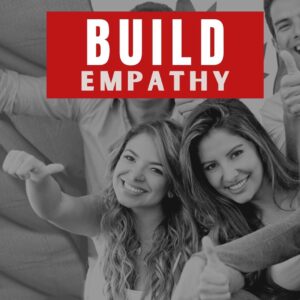 It used to surprise me that it became the school’s job to teach empathy. Shouldn’t parents do that? The truth is it doesn’t always happen in homes. Since children spend much of their daylight hours in school, it is a logical place to reinforce empathy as a life skill.
It used to surprise me that it became the school’s job to teach empathy. Shouldn’t parents do that? The truth is it doesn’t always happen in homes. Since children spend much of their daylight hours in school, it is a logical place to reinforce empathy as a life skill.
Edsurge has an interesting article, How to build empathy among students, that shares one teacher’s experiences:
Lessons in empathy often are taught with a focus on the individual, rather than the collective community, writes Ka’ua Adams, a ninth-grade English teacher at Kealakehe High School in Kona, Hawaii. In this commentary, Adams suggests strengthening these lessons by shifting individual activities to collective ones and focusing on care instead of skills.
Read on… (may require a free membership)
Ask a Tech Teacher has covered this topic often in the past. Here are some articles you might like:
- How to Put Kindness in Your Classes
- The Importance of SEL to Education Success
- Comics–an underused tool to boost SEL skills
- 9 Ways to Teach Tolerance
Share this:
- Click to share on Facebook (Opens in new window) Facebook
- Click to share on X (Opens in new window) X
- Click to share on LinkedIn (Opens in new window) LinkedIn
- Click to share on Pinterest (Opens in new window) Pinterest
- Click to share on Telegram (Opens in new window) Telegram
- Click to email a link to a friend (Opens in new window) Email
- More
What is ‘Technical Math’?
The difficulties with engaging children in math learning grows each year. I have several articles coming up next week that discuss that issue (links won’t work until publication date):
What is ‘Technical Math’–December 10, 2021 (this article)
Returning to Rigorous Mathematics–December 16, 2021
Math Scores Drop Again–December 17, 2021
An excellent solution is to change the focus, teach kids what will be required. One of our Ask a Tech Teacher partners has a good article on that topic:
What Is Technical Math?
 There’s an old joke about how kids are forced to learn algebra and trigonometry in school, but have no use for those subjects in real life. But in reality, that depends heavily on what kind of profession you choose to go into. A lot of professions you might think wouldn’t call for much math actually require it as a core skill set for certain trades, including plumbers, electricians, welders, and construction workers.
There’s an old joke about how kids are forced to learn algebra and trigonometry in school, but have no use for those subjects in real life. But in reality, that depends heavily on what kind of profession you choose to go into. A lot of professions you might think wouldn’t call for much math actually require it as a core skill set for certain trades, including plumbers, electricians, welders, and construction workers.
Why do trades like this require so much mathematics? These are supposed to be the jobs you don’t need extensive education for, right? Well, as it turns out, they’re not.
In fact, many technical trades require more math than some white-collar professions. Let’s look at welding, for example. To excel in their profession, a welder needs to understand and calculate concepts like material usage, which requires using fractions and sometimes algebra. They’ll also need to know how to use charts and graphs for some processes.
The same is true of construction workers, who must deal with equations, conversion of quantities, and taking measurements. In a typical workday, a construction worker may have to use equations to convert between units of measure, or use ratios to figure out the proportion of a roof’s length to its height. Getting some calculations wrong in construction work can have dangerous, if not deadly, consequences. In more advanced construction work (i.e. the jobs that pay well), they’ll even have to know some geometry.
The skills required for these sorts of jobs comes from a particular field, called “trade math” or “technical math.”
Share this:
- Click to share on Facebook (Opens in new window) Facebook
- Click to share on X (Opens in new window) X
- Click to share on LinkedIn (Opens in new window) LinkedIn
- Click to share on Pinterest (Opens in new window) Pinterest
- Click to share on Telegram (Opens in new window) Telegram
- Click to email a link to a friend (Opens in new window) Email
- More
Artificial Intelligence in Education: Anecdotal Evidence
Artificial Intelligence has made its way into our classrooms. Good or bad, only time will tell but some early reports say there are some real positives about using AI-powered program to boost literacy. Here’s an article from Hechinger Report, a national nonprofit newsroom that reports only on education, that’s pretty interesting:
Can an AI tutor teach your child to read?
When Jaclyn Brown Wright took over as principal of Brewbaker Primary School in Montgomery, Alabama, she knew she needed to figure out a way to boost literacy rates. At Brewbaker, which in 2020 served more than 700 students in pre-K through second grade, nearly 20 percent of her students are English learners and 71 percent are economically disadvantaged. In 2019, a year before Brown Wright was hired, less than 20 percent of students were proficient on the school’s reading assessments, the principal said. Brown Wright knew the stakes were high: In Alabama, students can be held back if they are not reading at grade level by the end of third grade.
We’ve discussed artificial intelligence often at Ask a Tech Teacher. Here are a few articles you may find interesting:
Digital Assistants in the Classroom
8 Practical Ways to use AI in Learning
Share this:
- Click to share on Facebook (Opens in new window) Facebook
- Click to share on X (Opens in new window) X
- Click to share on LinkedIn (Opens in new window) LinkedIn
- Click to share on Pinterest (Opens in new window) Pinterest
- Click to share on Telegram (Opens in new window) Telegram
- Click to email a link to a friend (Opens in new window) Email
- More
Tech to Help With Masks
The pandemic has changed teaching in many ways–remove vs. in-person vs. hybrid for one, the need for internet access in homes for another. Schools struggle to find the right technology to address these many changing needs. One that caught my eye was reported in The Dispatch–technology to address the sometimes garbled communication that results from speaking through masks. Here’s their interesting story:
New tech installed at SOCSD helps with teaching through masks
Starkville High School student Peyton Willoughby sat in his 10th grade English class Thursday not worried about struggling to hear his teacher because of new technology installed in the classroom.
As his teacher discussed poems and literary elements, information flowed throughout speakers across the entire room, giving Willoughby the assurance that he was obtaining all of the necessary material.
“For me, I really love (this new technology),” Willoughby said. “I think it’s absolutely amazing because the teacher can be up and vocal and moving around while still maintaining that audibility … it makes the teaching much more engaging and more enjoyable.”
For more about teaching through COVID, here are a few more articles:
- Teaching During COVID-19
- Teaching Online During COVID-19
- 8 Ways Parents and Teachers Support Remote Teaching
Share this:
- Click to share on Facebook (Opens in new window) Facebook
- Click to share on X (Opens in new window) X
- Click to share on LinkedIn (Opens in new window) LinkedIn
- Click to share on Pinterest (Opens in new window) Pinterest
- Click to share on Telegram (Opens in new window) Telegram
- Click to email a link to a friend (Opens in new window) Email
- More
SEL in Your Classroom
SmartBrief, news on technology in education, recently published an article, Uniting technology and SEL to teach the whole child, on the importance of SEL (Social-Emotional Learning) in an educational landscape shaped by COVID-19. In part, they shared:
Social-emotional learning is seeing a surge in mentions in the educational landscape. Most recently, the COVID-19 pandemic clearly illuminated the fact that academic growth and social and emotional wellness are interdependent and that educators must take into account the social and emotional aspects of a student’s reality as they consider academic development.
I know firsthand the power of SEL, both as a teacher and as a former student. I was born and raised in the rural mountains of North Carolina and was greatly influenced by a teacher who led with compassion. This educator forever changed my life because she saw “the whole child” — she recognized me as more than my abilities in reading and math. She saw me as a hurt child from a broken home, although it was the only home I knew, and knew she could help me reach my potential by engaging me on a social and emotional level.
For more background on SEL, check out our article discussing “The Importance of SEL to Education Success“:
Life is much simpler when you — as a parent or teacher — can point to one solution for a problem, solve it, and everything is golden. Success in school was like that when grades were the barometer and studying harder was the tool. Now, we know academic achievement is much more complicated.
“Students are telling us there’s a big missing piece in their education” –John Bridgeland, CEO of Civic
Today’s educators realize learning has as much to do with academics as how students get along with themselves and others. This is called “Social Emotional Learning” or SEL. It’s akin to the importance of play in teaching preschool kids to socialize with others, develop tenacity, and learn respect for those around them. If you’re not convinced of the importance of SEL, here’s what students say:
“Students and young adults believe SEL schools would create a more positive social and learning environment” — report by the Collaboration for Academic, Social and Emotional Learning (CASEL)
A positive attitude about themselves and others is linked to not only academic success but correlated to lessening the negative impact of future-ending problems such as drug use. It should surprise no one that as of mid-2018, two states have passed SEL measures, sixteen SEL-related bills and resolutions have been introduced, and twenty-three states are working on SEL standards.
-
- What is SEL
- Why teach SEL in schools
- SEL exercises
- SEL resources
- Vocabulary
- More
Share this:
- Click to share on Facebook (Opens in new window) Facebook
- Click to share on X (Opens in new window) X
- Click to share on LinkedIn (Opens in new window) LinkedIn
- Click to share on Pinterest (Opens in new window) Pinterest
- Click to share on Telegram (Opens in new window) Telegram
- Click to email a link to a friend (Opens in new window) Email
- More
Technology and Teaching: A Conversation with Teachers
Ask a Tech Teacher contributor, Christian Miraglia, taught for 36 years before retiring. Here is Part 2 of his discussion on technology’s place in education:
Part II Technology is Here to Stay: A Conversation with Teachers
 In my previous post, I wrote about the permanency of technology in the instructional setting for educators. Over the past weeks, I have spoken to a few educators about what has changed for them in this area. There is no doubt that the use of tech tools beyond the general record-keeping for attendance and grading has now found a footing in most classrooms around the nation. Some teachers who were initially hesitant to jump into the depths of technology integration find themselves fully immersed. Some who were on the proverbial edge of the diving board have been pushed into the pool and some have embraced the change with the excitement of a child playing with a new toy.
In my previous post, I wrote about the permanency of technology in the instructional setting for educators. Over the past weeks, I have spoken to a few educators about what has changed for them in this area. There is no doubt that the use of tech tools beyond the general record-keeping for attendance and grading has now found a footing in most classrooms around the nation. Some teachers who were initially hesitant to jump into the depths of technology integration find themselves fully immersed. Some who were on the proverbial edge of the diving board have been pushed into the pool and some have embraced the change with the excitement of a child playing with a new toy.
I recently spoke with a fellow history teacher who has embraced the technology and been quite creative in the process. With a focus on the social-emotional component of instruction, he utilized a master Google Slide deck coupled with one of the Eduprotocols skills such as Number Mania or Iron Chef and the content he was covering. This procedure allowed him to see all of his students responding to the prompt and kept him connected to the students throughout the year. Taking the learning to another level as well as incorporating the 21st Century skill of communication, his students showed their parents an exhibit using Flipgrid they had built based on the unit essential question. Without the use of this recording tool, the work would have been relegated to the school’s LMS as a click-through for the teacher. Moreover, with the exhibit being published, the student’s parents now had validation of their child’s work. Very powerful indeed.
Another teacher found that utilizing an IDE (Integrated Development Environment) that was cloud-based gave her students round-the-clock access to work in their programming class instead of relying on a downloaded file to a school computer. In our current environment, this addresses the issue of student access to content extending beyond the limitations to work only done in between walls of the classrooms.
In another conversation with a colleague of mine who is also a history teacher at the high school level, it was pointed out that because students were just glad to be back in a classroom setting they embraced any assignment that he pushed out. Because of the social distancing mandate in his district, it was important that he be strategic in his instructional strategy. In the previous year of pandemic instruction, he explored how discussion panels could be used specifically using Canvas. He found that students were inclined to post well-thought responses as they looked forward to the feedback from their peers. The same collaborative approach was taken once students returned back to school in the summer utilizing the Eduprotocols. Once school started a couple of weeks ago with limitations on classroom movement students were able to collaborate on Google slides and communicate with each other by using the same strategy. More importantly, after students collaborated they had to report out on their choices. The selection of the strategy and technology tool was very intentional to create a more engaging environment as well as providing for a platform for the students learning experience.
Share this:
- Click to share on Facebook (Opens in new window) Facebook
- Click to share on X (Opens in new window) X
- Click to share on LinkedIn (Opens in new window) LinkedIn
- Click to share on Pinterest (Opens in new window) Pinterest
- Click to share on Telegram (Opens in new window) Telegram
- Click to email a link to a friend (Opens in new window) Email
- More





